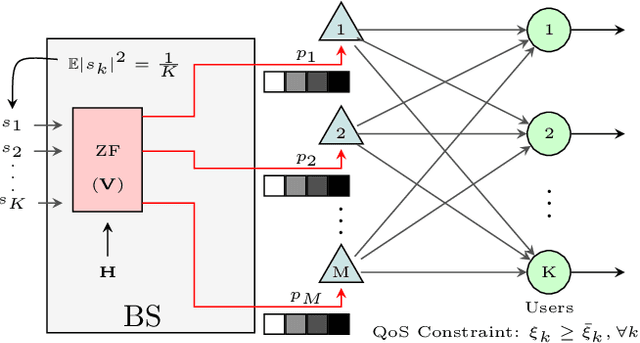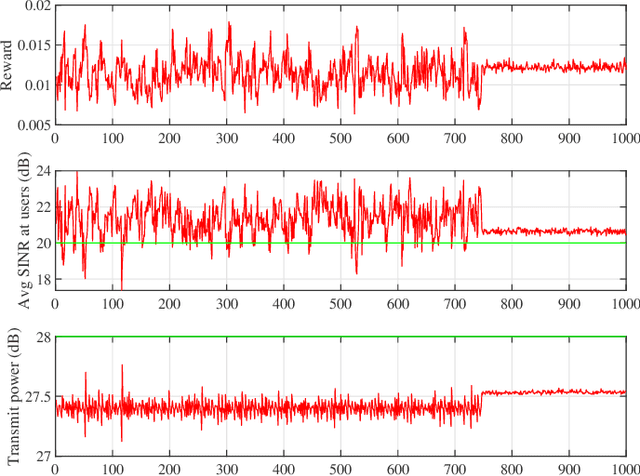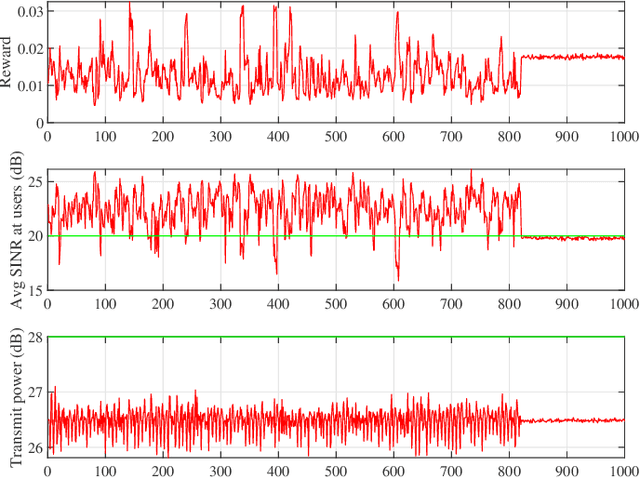Navneet Garg
Joint Power Allocation and Beamforming for In-band Full-duplex Multi-cell Multi-user Networks
Mar 16, 2024



Abstract:This paper investigates a robust joint power allocation and beamforming scheme for in-band full-duplex multi-cell multi-user (IBFD-MCMU) networks. A mean-squared error (MSE) minimization problem is formulated with constraints on the power budgets and residual self-interference (RSI) power. The problem is not convex, so we decompose it into two sub-problems: interference management beamforming and power allocation, and give closed-form solutions to the sub-problems. Then we propose an iterative algorithm to yield an overall solution. The computational complexity and convergence behavior of the algorithm are analyzed. Our method can enhance the analog self-interference cancellation (ASIC) depth provided by the precoder with less effect on the downlink communication than the existing null-space projection method, inspiring a low-cost but efficient IBFD transceiver design. It can achieve 42.9% of IBFD gain in terms of spectral efficiency with only antenna isolation, while this value increases to 60.9% with further digital self-interference cancellation (DSIC). Numerical results illustrate that our algorithm is robust to hardware impairments and channel uncertainty. With sufficient ASIC depth, our method reduces the computation time by at least 20% than the existing scheme due to its faster convergence speed at the cost of < 12.5% sum rate loss. The benefit is much more significant with single-antenna users that our algorithm saves at least 40% of the computation time at the cost of < 10% sum rate reduction.
On the Secrecy Rate of In-Band Full-duplex Two-way Wiretap Channel
Mar 11, 2024Abstract:In this paper, we consider a two-way wiretap Multi-Input Multi-Output Multi-antenna Eve (MIMOME) channel, where both nodes (Alice and Bob) transmit and receive in an in-band full-duplex (IBFD) manner. For this system with keyless security, we provide a novel artificial noise (AN) based signal design, where the AN is injected in both signal and null spaces. We present an ergodic secrecy rate approximation to derive the power allocation algorithm. We consider scenarios where AN is known and unknown to legitimate users and include imperfect channel information effects. To maximize secrecy rates subject to the transmit power constraint, a two-step power allocation solution is proposed, where the first step is known at Eve, and the second step helps to improve the secrecy further. We also consider scenarios where partial information is known by Eve and the effects of non-ideal self-interference cancellation. The usefulness and limitations of the resulting power allocation solution are analyzed and verified via simulations. Results show that secrecy rates are less when AN is unknown to receivers or Eve has more information about legitimate users. Since the ergodic approximation only considers Eves distance, the resulting power allocation provides secrecy rates close to the actual ones.
Reinforcement Learning based Per-antenna Discrete Power Control for Massive MIMO Systems
Jan 28, 2021


Abstract:Power consumption is one of the major issues in massive MIMO (multiple input multiple output) systems, causing increased long-term operational cost and overheating issues. In this paper, we consider per-antenna power allocation with a given finite set of power levels towards maximizing the long-term energy efficiency of the multi-user systems, while satisfying the QoS (quality of service) constraints at the end users in terms of required SINRs (signal-to-interference-plus-noise ratio), which depends on channel information. Assuming channel states to vary as a Markov process, the constraint problem is modeled as an unconstraint problem, followed by the power allocation based on Q-learning algorithm. Simulation results are presented to demonstrate the successful minimization of power consumption while achieving the SINR threshold at users.
 Add to Chrome
Add to Chrome Add to Firefox
Add to Firefox Add to Edge
Add to Edge